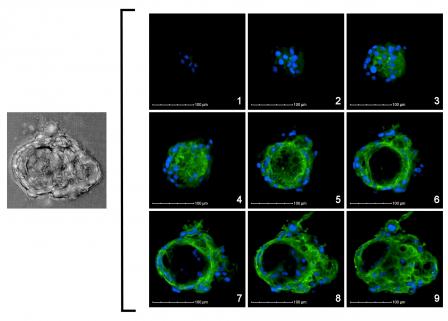EPA Scientists Model Human Systems to Understand Children's Environmental Health Impacts
 Image of a 3D thyroid microtissue. The image series represents cross-sectional slices of the microtissue to demonstrate the cellular organization in a 3D culture model.Published November 10, 2020
Image of a 3D thyroid microtissue. The image series represents cross-sectional slices of the microtissue to demonstrate the cellular organization in a 3D culture model.Published November 10, 2020
Children’s health is at the forefront of EPA’s research to protect human health and the environment. In order to reduce potential developmental disorders caused by chemical exposure, researchers at EPA are using Virtual Tissue Models (VTM) to understand a chemical’s effects on developing embryos. This information will help to fill data gaps associated with a chemical’s hazard profile and inform efforts to predict adverse chemical effects.
Virtual Tissue Models (VTM) use in vitro (cell cultures) and in vivo (animal) data to model biological processes observed during development and predict key events that chemicals might disrupt and cause adverse effects. Researchers simulate the introduction of chemicals to the virtual tissue models and record the changes to biological functions. They then compare the results to existing animal data from toxicity studies. This helps them strengthen the predictive capabilities of these systems. VTM research emphasizes the use of Organotypic Culture Models (OCM), which are in vitro models that represent human tissues both physically and toxicologically. Organotypic Culture Models are 3-D arrangements of tissue-specific cells that more accurately emulate a tissue’s response to chemical exposure than simply cells in a petri dish.
EPA researcher Dr. Thomas Knudsen uses biological knowledge and in vitro data from high-throughput screening to build and test computational models that simulate how the embryo develops. In a virtual embryo simulation, biological responses to chemical perturbations emerge through cell to cell interactions. These models allow for the testing of hypotheses regarding the consequences of chemical exposure, including, for example, how genetic changes can be used to quantitatively predict chemical-induced morphological (structural) changes. Current models focus on blood vessel development, cleft palate formation, and hypospadias. This project will eventually feature many developmental processes to further support predictive models of birth defects commonly attributed to chemical exposure.
In addition, EPA researcher Dr. Chad Deisenroth primarily focuses on screening chemicals for potential endocrine disruption, including evaluating chemicals for estrogen, androgen, and thyroid hormone effects that are potentially hazardous during pregnancy and early childhood development. Insufficient thyroid hormone levels can permanently impair brain development and other critical organ systems so identifying chemicals with thyroid-disrupting effects is essential to protecting children’s health. The current in vitro test systems are limited in their capacity to predict functional effects of chemicals in the intact thyroid gland. Deisenroth’s work has established a novel OCM of the human thyroid to evaluate the impact of chemicals on thyroid hormone production to better understand the human relevance of these exposures, and the likelihood of altering the normal physiological function of the thyroid.
As stronger in vitro and in silico (computational) models emerge, the reliance on animal testing to determine effects on human developmental health will be reduced. Currently, EPA has strong confidence in data-driven models for predicting chemical effects on angiogenesis (blood vessel development), and on embryonic stem cells. In addition to helping predict potential impacts of chemicals on developing embryos, these efforts have the added benefit of helping to meet EPA’s goals of reducing animal testing.
Learn More
EPA New Approach Methods Work Plan: Reducing Use of Animals in Chemical Testing
